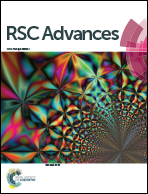Development of porous carbon nanofibers from electrospun polyvinylidene fluoride for CO2 capture†
Abstract
Highly porous carbon nanofibers (CNFs) are successfully prepared for CO2 capture from the carbonization of electrospun polyvinylidene fluoride (PVDF). In the CNF preparation, different temperatures in the range 300–1000 °C are applied for carbonization, and the effect of temperature is investigated. Well-developed porosities and enhanced CO2 adsorption uptakes are achieved by applying a large degree of carbonization at temperatures of 400 °C or above. In the carbonization at high temperatures, narrow micropores (<0.7 nm) are predominantly developed in the PVDF-based CNFs, contributing to an increase of specific surface area and pore volume up to 1065 m2 g−1 and 0.61 cm3 g−1, respectively. The highest CO2 adsorption uptake of 3.1 mol kg−1 is measured at 30 °C and ∼1 atm for PVDF-based CNF carbonized at 1000 °C. PVDF-based CNFs also display excellent recyclability and rapid adsorption–desorption kinetics, which make PVDF-based CNFs promising adsorbents for CO2 capture.


 Please wait while we load your content...
Please wait while we load your content...